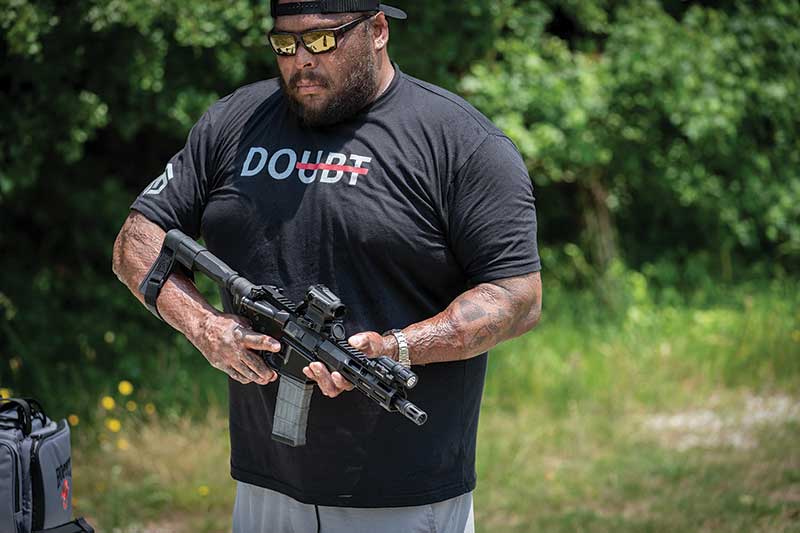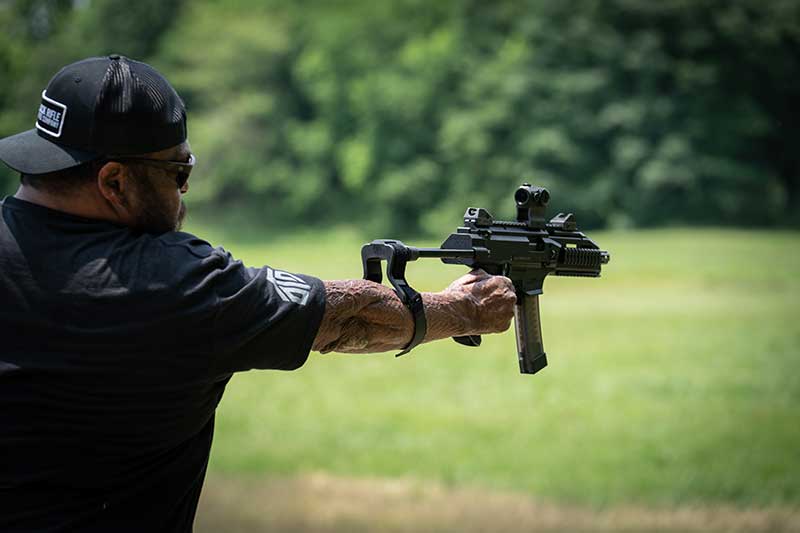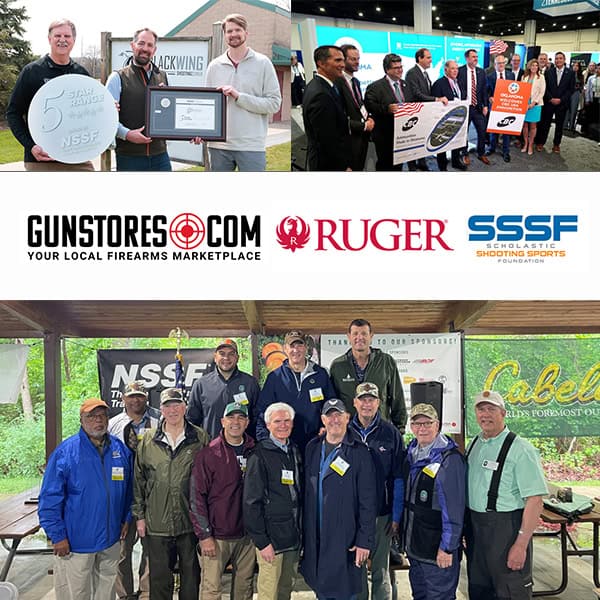ATF Renews Attempt To
Regulate Stabilizing Braces
At the close of 2020, ATF published a Proposed Rule Guidance in the Federal Register to classify firearms with stabilizing braces (“Notice on the Objective Factors for Classifying Weapons with ‘Stabilizing Braces’”) — inviting public comment from Dec. 18, 2020 through Jan. 1, 2021.
The timing of this announcement and the shortened window for comments were widely panned as a not-so-subtle attempt to legislate during what’s normally a quiet time of the year. However, thanks to more than 70,000 public comments and pushback from industry manufacturers and associations, ATF announced its withdrawal of the Proposed Rule Guidance just days later on Dec. 23.
While the industry celebrated the quick about-face, we wrote in our coverage in the Feb. 2021 issue the Proposed Rule served as a “warning sign of things to come in 2021.”
Well, June 7, ATF announced a renewed effort to regulate stabilizing braces with a Notice of Proposed Rule Making (NPRM): “Factoring Criteria for Firearms with Attached ‘Stabilizing Braces.’” Unlike the December Guidance, this ruling has a 90-day comment period — which ends Sept. 8.
The ruling comes during a period of heightened tensions between the firearms industry and ATF, with President Biden’s pick to lead the bureau (anti-gun lobbyist David Chipman) facing a close, hyper-partisan confirmation battle in the U.S. Senate.
In short, the NPRM proposes amending the definition of “rifle” to clarify it includes “any weapon with a rifled barrel and equipped with an attached ‘stabilizing brace’ that has objective design features and characteristics that indicate the firearm is designed to be fired from the shoulder, as indicated on ATF Worksheet 4999.”
Additionally, ATF explains the purpose of the amendments would be to target attachments to pistols the agency contends are designed to evade restrictions imposed by the Gun Control Act (GCA) and National Firearms Act (NFA).
“When a purported ‘stabilizing brace’ and an attached weapon’s objective design features indicate that the firearm is actually designed and intended to be fired from the shoulder, such weapon may fall within the scope of the NFA, requiring registration and payment of tax,” the proposed rule reads.
As currently written, millions of law-abiding consumers would suddenly find themselves felons overnight if this rule advances. Additionally, it would have significant implications for the industry as a whole.
To gain additional insights, SI sat down with Jeff Creamer, president and CEO of SB Tactical — who argued this move represents a blatant attack on the industry and called on industry companies and gun owners to get involved and make their opinions known.
The Ruling’s Ramifications
Known as the originator of the forearm pistol stabilizing brace, SB Tactical is firmly entrenched in this segment — which has grown into a formidable economic force with dozens of companies involved in the production and deployment of pistol stabilizing braces, to the tune of over $1 billion a year. Creamer provided his team’s initial reaction to the ATF’s NPRM.
“Let’s call it what it is: It’s the largest executive branch firearms ban or registration scheme in American history,” he said. “To call it a proposal to regulate or put standardization on brace firearms is a fallacy. It’s strictly a registration/confiscation scheme.”
Creamer labeled this an outright attack on gun owners — rather than a “public safety issue” as argued by ATF. The numbers speak for themselves.
“The ATF is citing a public safety issue, but yet they can only cite two crimes committed with a braced firearm,” he shared. “The Congressional Research Service estimates there are between 10–40 million firearms in circulation with pistol stabilizing braces. While ATF estimates it to be 3 million, let’s do the math: two incidents out of 3 million? Come on.”
A significant problem facing the millions of lawful owners of pistol stabilizing braces: the ATF’s NPRM rejects grandfathering.
“This leaves millions — millions — of lawful gun owners who relied on ATF guidance in the past with few options,” Creamer stated. “They can add a longer barrel to their firearm, surrender their firearm to ATF, remove the brace and destroy it, but only if they assembled the gun themselves, or pay a $200 tax stamp and wait nine months to a year — or what will likely be years if all are submitted at once.”
“Ultimately, this isn’t just a brace issue: It’s a fundamental attack on the industry and law-abiding consumers. Every channel — OEMs, distributors, dealers and consumers — is impacted. This has got to resonate with every gun owner and every dealer.”
Jeff Creamer, President & CEO SB Tactical
This ruling also places dealers in a compromising position, Creamer noted.
“Through no fault of the dealer, who relied on past guidance, he’s now going to have to tell the customer who he sold a pistol to and explain the pistol he sold now makes the customer a felon because he’s in possession of it ‘illegally,’” he said.
Another source of consternation is the inconsistency in the point system established in ATF Worksheet 4999 (“Factoring Criteria For Rifled Barrel Weapons With Accessories”).
“What the ATF is ostensibly saying is, ‘We’ve created this point scheme and if you don’t meet the threshold of the point scheme, then you’re in illegal possession of a non-registered NFA weapon. However, if you do meet the threshold, we may decide it doesn’t matter and you’re trying to circumvent the NFA and therefore you’re in possession of a non-registered NFA weapon,” Creamer argued.
Similar to the Dec. 2020 Proposed Rule, this latest ruling has led to uncertainty, rather than clarity, Creamer contended.
“With this latest ruling, ATF has created confusion and distrust that will ripple throughout the industry for years,” he predicted.
Soliciting Support
Back in December, when the ATF rescinded its notice, the industry celebrated this as a “win.” When asked what would constitute a “win” in this situation, Creamer noted two sides to the equation.
“If ATF withdrew the NPRM, it would be a win. But they also would view it as a ‘win’ because they’ve sown so much confusion into the market. People in general are going to be less anxious to embrace the category because it’s going to happen again.”
Creamer continued, “A ‘win’ for the industry would be reasonable, clear metrics on defining a brace and braced handguns so a manufacturer, end user or dealer could look at a weapon and say ‘that’s a handgun’ or ‘no, that doesn’t fit the criteria, that’s an SBR.’ But I don’t foresee ATF giving that up.”
As of mid-July, there were well over 100,000 public comments submitted on this rule. Noted earlier, the comment period runs through September 8, and Creamer encouraged dealers to be involved in education efforts and solicit support.
“Taking the opportunity to use the system, in this case the APA [Administrative Procedure Act] and rulemaking process for people within the industry and end users to comment why this is wrong is very important. This is why the process exists — otherwise they could have simply made the rule and that would be it,” he said.
Creamer emphasized this isn’t just an attack on SB Tactical or other brace manufacturers. This segment, which includes firearms manufacturers, OEM manufacturers, barrel makers, handguard producers, machinists and other businesses, has a far-reaching economic footprint.
“Ultimately, this isn’t just a brace issue: It’s a fundamental attack on the industry and law-abiding consumers. Every channel — OEMs, distributors, dealers and consumers — is impacted. This has got to resonate with every gun owner and every dealer,” he concluded.
Editor’s Note: SB Tactical has included a detailed summary of this proposed rule on its website, as well as tips/links to submit comments on the Federal Register.






